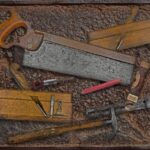Are you a woodworking enthusiast looking to achieve precision and professional results in your projects? Look no further than the use of diamond sharpening stones. In the world of woodworking, having sharp tools is crucial for achieving clean cuts and smooth finishes.
Diamond sharpening stones are an essential tool for maintaining the sharpness of woodworking tools such as chisels, plane irons, and carving knives. This article will explore the various aspects of using diamond sharpening stones in woodworking, including how to choose the right one, the benefits they offer, and expert tips for getting the best results.
When it comes to sharpening woodworking tools, using a diamond sharpening stone is highly recommended for its durability and effectiveness. These stones are coated with industrial-grade diamonds, making them extremely hard and long-lasting. Whether you’re a beginner or a seasoned woodworker, having a high-quality diamond sharpening stone is indispensable for keeping your tools in top condition.
In this comprehensive guide, we will cover everything you need to know about diamond sharpening stones for woodworking. From choosing the right stone for your specific needs to learning how to maintain and care for it properly, we’ve got you covered.
Additionally, we’ll provide a step-by-step guide on how to use a diamond sharpening stone to achieve razor-sharp edges on your woodworking tools. So let’s dive in and explore the world of diamond sharpening stones in woodworking.
How to Choose the Right Diamond Sharpening Stone for Woodworking
When choosing the right diamond sharpening stone for woodworking, it is important to consider several factors to ensure that you get the best results. With a variety of options available in the market, knowing what to look for can help you make an informed decision and invest in a sharpening stone that meets your woodworking needs.
Grit Size and Coarseness
One of the most crucial factors to consider when choosing a diamond sharpening stone for woodworking is the grit size. The grit size determines the coarseness of the stone, and different coarseness levels are suitable for various woodworking tools. For example, a lower grit size (coarser stone) is ideal for repairing damaged or dull edges, while a higher grit size (finer stone) is perfect for polishing and refining edges.
Size and Shape
The size and shape of the diamond sharpening stone are also important considerations. The size should be compatible with the type of woodworking tools you intend to sharpen. A larger stone may be more suitable for larger tools such as planes and chisels, while a smaller stone may be better suited for smaller blades or detail work. Additionally, consider whether you prefer a rectangular bench stone or a more portable option such as a folding diamond sharpener.
Quality and Durability
Investing in a high-quality diamond sharpening stone is essential for achieving precise and consistent results in woodworking. Look for stones made from industrial-grade diamonds bonded to a durable base material such as steel or aluminum. Additionally, consider stones with continuous diamond surfaces rather than coated ones, as they tend to offer better performance and longevity.
By carefully considering these factors – grit size, size and shape, as well as quality and durability – you can choose the right diamond sharpening stone that aligns with your specific woodworking requirements and helps you achieve precision in your craft.
Benefits of Using Diamond Sharpening Stones for Woodworking
Diamond sharpening stones have become increasingly popular among woodworkers for their efficiency and effectiveness in sharpening woodworking tools. There are numerous benefits to using diamond sharpening stones for woodworking, making them a valuable investment for any woodworker.
One of the major advantages of diamond sharpening stones is their durability. Unlike traditional waterstones or oilstones, diamond sharpening stones are constructed with industrial-grade diamonds, which makes them extremely hard and long-lasting. This means that they do not require flattening as often as other types of sharpening stones, saving time and effort in the long run.
Another key benefit of using diamond sharpening stones for woodworking is their ability to provide consistent results. The hard, abrasive surface of diamond stones allows for quick and efficient removal of material from the cutting edge of woodworking tools, resulting in a sharp and precise edge every time. This level of consistency is crucial in woodworking, where precision is paramount for achieving high-quality results.
In addition to their durability and consistency, diamond sharpening stones are also known for their versatility. They can be used to sharpen a wide range of woodworking tools, including chisels, planes, gouges, carving knives, and more.
This makes them a practical choice for woodworkers who work with various types of tools and need a reliable sharpening solution that can accommodate different blade shapes and sizes. Overall, the benefits of using diamond sharpening stones in woodworking make them an essential tool for maintaining sharp and efficient cutting edges on woodworking tools.
Step-by-Step Guide on Sharpening Woodworking Tools With a Diamond Sharpening Stone
Preparation
Before you begin sharpening your woodworking tools with a diamond sharpening stone, it’s important to properly prepare the area. Make sure your work surface is clean and stable, and that you have all the necessary tools and safety gear at hand. This includes your diamond sharpening stone, the woodworking tools you will be sharpening, a honing guide (if needed), and protective gloves and goggles.
Setting Up Your Diamond Sharpening Stone
Start by placing your diamond sharpening stone on a flat, stable surface. Some sharpening stones come with a non-slip base to prevent any movement during use. If yours doesn’t have this feature, consider using a damp towel or rubber mat underneath to keep it from sliding around. It’s also important to make sure the stone is clean before use, as any debris or residue can affect its performance.
Sharpening Process
When sharpening woodworking tools with a diamond sharpening stone, it’s essential to maintain the correct angle between the tool blade and the stone. This can be achieved by using a honing guide or by practicing a consistent hand technique. Begin by holding the tool firmly against the stone at the proper angle and applying even pressure as you move it back and forth across the surface of the stone.
Be sure to work each side of the blade evenly to maintain symmetry. After several strokes on each side, check for any burrs along the edge of the tool, which can be removed by simply stroking backwards on the stone.
By following these essential steps when using a diamond sharpening stone for your woodworking tools, you can ensure that they remain sharp and durable for all your woodworking projects.
Maintenance and Care Tips for Diamond Sharpening Stones in Woodworking
Diamond sharpening stones are powerful tools that help woodworkers keep their tools sharp and precise. However, to maintain the effectiveness of these stones, it is crucial to take care of them properly. Here are some maintenance and care tips for diamond sharpening stones in woodworking:
First, it is essential to regularly clean the diamond sharpening stone after each use. This can be done by using a brush or mild soap and water to remove any metal particles or debris that may have accumulated on the surface. Keeping the stone clean will ensure that it continues to provide a smooth and consistent sharpening surface.
Additionally, it is important to store diamond sharpening stones properly when not in use. They should be kept in a dry place to prevent any moisture buildup that could potentially damage the stone’s surface. Some woodworkers also prefer storing their diamond sharpening stones in a protective case or sleeve to prevent any accidental damage.
Lastly, it is recommended to periodically flatten diamond sharpening stones to maintain a level and consistent surface for sharpening woodworking tools. This can be done using a flattening plate or another flat surface with abrasive material such as silicon carbide grit. Regularly flattening the stone will ensure that it continues to provide precise and efficient sharpening for woodworking tools.
Overall, proper maintenance and care of diamond sharpening stones are essential in ensuring their longevity and effectiveness in woodworking projects.
| Maintenance Tips | Care Tips |
|---|---|
| Regularly clean after each use with mild soap and water | Store in a dry place to prevent moisture buildup |
| Periodically flatten the stone for a level surface | Consider storing in a protective case or sleeve |
Comparison of Diamond Sharpening Stones With Other Sharpening Methods in Woodworking
Diamond sharpening stones are a popular choice for woodworkers due to their durability and efficiency in sharpening woodworking tools. However, it’s essential to compare diamond sharpening stones with other sharpening methods to understand their advantages and disadvantages in woodworking.
When comparing diamond sharpening stones with other sharpening methods in woodworking, it’s important to consider factors such as material removal rate, ease of use, maintenance, and cost. Here is a comparison between diamond sharpening stones and other common sharpening methods:
- Water Stones: Water stones are known for their ability to produce a razor-sharp edge on woodworking tools. They require soaking in water before use and need to be flattened regularly. While water stones can achieve a very sharp edge, they tend to wear down faster compared to diamond sharpening stones.
- Oil Stones: Oil stones are another traditional sharpening method that requires lubrication with oil during use. They are known for producing a polished edge on woodworking tools. However, oil stones also require flattening and maintenance, and they may not be as efficient as diamond sharpening stones in terms of material removal.
- Ceramic Stones: Ceramic sharpening stones are known for their hardness and ability to produce a fine edge on woodworking tools. They are low maintenance and do not require soaking or lubrication. However, ceramic stones may not be as aggressive as diamond sharpening stones when it comes to reshaping or repairing damaged edges on woodworking tools.
In comparison to these traditional sharpening methods, diamond sharpening stones offer several benefits for woodworking enthusiasts. Diamond abrasives have a high material removal rate, which means they can quickly reshape and repair the edges of woodworking tools. Additionally, diamond sharpening stones do not require soaking or lubrication, making them convenient and easy to use for woodworkers.
Ultimately, the choice between diamond sharpening stones and other methods depends on the specific needs of the woodworker and the type of woodworking tools being used. Each method has its own advantages and limitations, but diamond sharpening stones stand out for their efficiency and long-lasting durability in the workshop.
Common Mistakes to Avoid When Using Diamond Sharpening Stones in Woodworking
When using diamond sharpening stones in woodworking, it’s important to be aware of common mistakes that can affect the quality and effectiveness of your sharpening process. By avoiding these mistakes, you can ensure that your tools are properly sharpened and ready for use.
Some common mistakes to avoid when using diamond sharpening stones in woodworking include:
- Using too much or too little pressure: Applying excessive pressure when sharpening your tools can cause uneven sharpening and wear down the stone prematurely. On the other hand, using too little pressure may result in ineffective sharpening. It’s essential to find the right balance of pressure for optimal results.
- Not maintaining a consistent angle: One of the key factors in achieving a sharp edge is maintaining a consistent angle while sharpening. Failing to do so can lead to an uneven edge and may require more effort to correct. Take your time to ensure that you are holding the tool at the correct angle throughout the sharpening process.
- Skipping grit levels: Diamond sharpening stones come in different grit levels, each serving a specific purpose in the sharpening process. Skipping grit levels or not properly progressing through them can result in a less-than-ideal sharpness on your tools. It’s important to start with a coarser grit and progress to finer grits for the best results.
By being mindful of these common mistakes and taking the time to sharpen your woodworking tools properly, you can make the most of your diamond sharpening stone and achieve precision in your woodworking projects. Avoiding these errors will help you maintain the effectiveness and longevity of your diamond sharpening stone, ensuring that it remains a valuable tool in your workshop arsenal.
Expert Tips and Tricks for Getting the Best Results With Diamond Sharpening Stone in Woodworking
When it comes to woodworking, using a diamond sharpening stone can make all the difference in achieving precise and clean cuts with your tools. To ensure that you are getting the best results with your diamond sharpening stone, there are some expert tips and tricks that you should keep in mind.
One important tip for getting the best results with a diamond sharpening stone in woodworking is to use the right amount of pressure. Applying too much pressure can cause uneven sharpening and even damage to your tools. Instead, use a light and steady hand when sharpening your woodworking tools to ensure a smooth and even finish.
Another expert tip for using a diamond sharpening stone in woodworking is to lubricate the stone properly. Using water or honing oil on the surface of the stone will help to prevent heat buildup and keep the stone clean during use. This will not only improve the effectiveness of the sharpening process but also prolong the life of your diamond sharpening stone.
In addition, it’s crucial to maintain a consistent angle when sharpening your woodworking tools with a diamond sharpening stone. Whether you are sharpening chisels, plane irons, or other cutting tools, maintaining a consistent angle throughout the sharpening process is vital for achieving optimal results. Take your time and pay close attention to maintaining this angle as you move your tool across the surface of the diamond sharpening stone.
Conclusion
In conclusion, diamond sharpening stones play a crucial role in achieving precision and maintaining the quality of woodworking tools. The use of diamond sharpening stones provides woodworkers with a reliable and efficient method to sharpen their tools, ensuring that each cut is clean and precise. By choosing the right diamond sharpening stone and following proper maintenance and care tips, woodworkers can maximize the benefits of using this method for tool sharpening.
One of the key benefits of using diamond sharpening stones in woodworking is the durability and longevity they offer. Unlike other sharpening methods, diamond stones have a longer lifespan and provide consistent results over time.
This reliability is essential for woodworkers who rely on sharp and precise tools to ensure the quality of their work. Additionally, the step-by-step guide provided in this article can help woodworkers effectively sharpen their tools without making common mistakes that could compromise the quality of their work.
It is important for woodworkers to understand that while there are various sharpening methods available, the precision achieved with diamond sharpening stones cannot be matched by other methods. The ability of diamond stones to maintain a flat surface and provide consistent abrasion makes them an invaluable tool in woodworking. By incorporating expert tips and tricks into their routine, woodworkers can enhance their skills and achieve exceptional results with diamond sharpening stone woodworking.
Frequently Asked Questions
What Grit Sharpening Stones Do I Need for Woodworking?
When it comes to sharpening stones for woodworking, it’s essential to choose the right grit. For coarse work, a grit between 120 and 400 is ideal. For finer sharpening, opt for grits between 800 and 1000.
Can You Use a Sharpening Stone in Wood?
Yes, you can definitely use a sharpening stone on wood. In fact, it is crucial to maintain sharp tools when working with wood to ensure clean cuts and precise craftsmanship. Sharpening stones are indispensable for this task.
Do Diamond Sharpening Stones Work?
Diamond sharpening stones are known for their durability and effectiveness. They work exceptionally well for sharpening woodworking tools such as chisels and plane blades. The diamond surface ensures efficient material removal and long-lasting use.

Hi everyone! I’m a woodworker and blogger, and this is my woodworking blog. In my blog, I share tips and tricks for woodworkers of all skill levels, as well as project ideas that you can try yourself.





